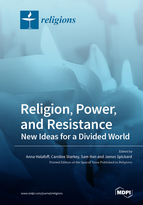Religion, Power, and Resistance: New Ideas for a Divided World
A special issue of Religions (ISSN 2077-1444).
Deadline for manuscript submissions: closed (15 February 2019) | Viewed by 64447
Special Issue Editors
Interests: intercultural and interreligious relations; countering violent extremism; education about religions and beliefs; sacred places; gender and Buddhism; and Buddhism in Australia
Special Issues, Collections and Topics in MDPI journals
Interests: social/cultural/critical theory, new media studies, religion, and East Asia (as well as their various overlaps and nodal points)
Interests: religion in contemporary Britain, particularly Buddhism
Interests: religion’s changing role in the contemporary world; causes of and solutions for homelessness; increasing social inequality and the decline of the middle class; research design
Special Issue Information
Dear Colleagues,
Focus of Special Issue
Current environmental, economic, social, and political challenges indicate that people are losing faith in existing power structures and mechanisms for coping with crises. This creates increasingly divided societies, riven by ideological battles for the future of the human and the more than human world. Religion has a place in this picture. Not only is it often a source of divisions; it can also be a source for alternative means of addressing them.
These divisions take new and as yet unclear shapes, which sociologists are only now beginning to comprehend. It is not enough to refer to the struggle between ‘tradition’ and ‘modernity’, terms that dominated sociology through the 1970s. Nor do the tropes ‘colonialism vs. anti-colonialism’ and the ‘clash of civilizations’ adequately explain what is going on. Nor, arguably, does ‘populism vs neo-liberalism’ fully capture such things as the recent clashes between cosmopolitan and anticosmopolitan actors in the major Western democracies. Each of these has a piece of the picture; none of them captures it all.
This Special Issue explores the following questions:
- What is religion’s role in this situation: as a creator of divisions, as a locus of power, and as a ground of resistance?
- How does religion influence our divided societies?
- How is religion influenced in turn?
Scope of Special Issue
The papers in this Special Issue have been drawn from the XIX International Sociological Association’s World Congress, Research Committee 22 on Sociology of Religion sessions, which took place in Toronto in July, 2018. They focused on religion and power, intersectional violence, social divisions, and also resistance to power, violence, and division. They included the following themes: religion and nationalism; religion and social theory; religion and diversity; religion and violent extremism; religion and gender inequality; religion and sexuality inequality; religion and environmental crises; and religion and violent and nonviolent social movements.
Dr. Anna Halafoff
Dr. Sam Han
Dr. Caroline Starkey
Prof. Dr. James Spickard
Guest Editors
Manuscript Submission Information
Manuscripts should be submitted online at www.mdpi.com by registering and logging in to this website. Once you are registered, click here to go to the submission form. Manuscripts can be submitted until the deadline. All submissions that pass pre-check are peer-reviewed. Accepted papers will be published continuously in the journal (as soon as accepted) and will be listed together on the special issue website. Research articles, review articles as well as short communications are invited. For planned papers, a title and short abstract (about 100 words) can be sent to the Editorial Office for announcement on this website.
Submitted manuscripts should not have been published previously, nor be under consideration for publication elsewhere (except conference proceedings papers). All manuscripts are thoroughly refereed through a double-blind peer-review process. A guide for authors and other relevant information for submission of manuscripts is available on the Instructions for Authors page. Religions is an international peer-reviewed open access monthly journal published by MDPI.
Please visit the Instructions for Authors page before submitting a manuscript. The Article Processing Charge (APC) for publication in this open access journal is 1800 CHF (Swiss Francs). Submitted papers should be well formatted and use good English. Authors may use MDPI's English editing service prior to publication or during author revisions.
Keywords
- religion
- power
- resistance
- social theory
- diversity






